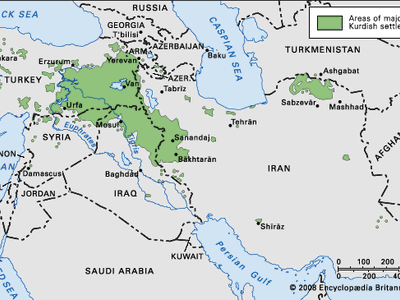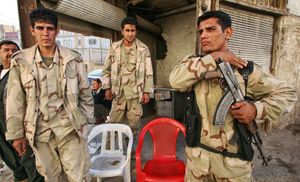Kurd
Our editors will review what you’ve submitted and determine whether to revise the article.
- Key People:
- Abdullah Öcalan Mustafa al-Barzani Badr Khānī Jāladat
Read a brief summary of this topic
Kurd, member of an ethnic and linguistic group living in the Taurus Mountains of southeastern Anatolia, the Zagros Mountains of western Iran, portions of northern Iraq, northeastern Syria, and western Armenia, and other adjacent areas. Most of the Kurds live in contiguous areas of Iran, Iraq, and Turkey—a somewhat loosely defined geographic region generally referred to as Kurdistan (“Land of the Kurds”). The name has different connotations in Iran and Iraq, which officially recognize internal entities by this name: Iran’s western province of Kordestān and Iraq’s Kurdish autonomous region. A sizable noncontiguous Kurdish population also exists in the Khorāsān region, situated in Iran’s northeast.
The Kurdish language and traditional way of life
The Kurdish language is a West Iranian language related to Persian and Pashto. The Kurds are thought to number from 25 million to 30 million, including communities in Armenia, Georgia, Kazakhstan, Lebanon, Syria, and Europe, but sources for this information differ widely because of differing criteria of ethnicity, religion, and language; statistics may also be manipulated for political purposes.
The traditional Kurdish way of life was nomadic, revolving around sheep and goat herding throughout the Mesopotamian plains and the highlands of Turkey and Iran. Most Kurds practiced only marginal agriculture. The enforcement of national boundaries beginning after World War I (1914–18) impeded the seasonal migrations of the flocks, forcing most of the Kurds to abandon their traditional ways for village life and settled farming; others entered nontraditional employment.
History
The prehistory of the Kurds is poorly known, but their ancestors seem to have inhabited the same upland region for millennia. The records of the early empires of Mesopotamia contain frequent references to mountain tribes with names resembling “Kurd.” The Kardouchoi whom the Greek historian Xenophon speaks of in Anabasis (they attacked the “Ten Thousand” near modern Zākhū, Iraq, in 401 bce) may have been Kurds, but some scholars dispute this claim. The name Kurd can be dated with certainty to the time of the tribes’ conversion to Islam in the 7th century ce. Most Kurds are Sunni Muslims, and among them are many who practice Sufism and other mystical sects. Although several historical dynasties have been led by Kurdish rulers, such as the Ḥasanwayhid dynasty, the ʿAnnazid dynasty, and, most famously, the Ayyubid dynasty, the Kurds have never achieved nation-state status in the modern era.
Social organization
The principal unit in traditional Kurdish society was the tribe, typically led by a sheikh or an aga, whose rule was firm. Tribal identification and the sheikh’s authority are still felt, though to a lesser degree, in the large urban areas. Detribalization proceeded intermittently as Kurdish culture became urbanized and was nominally assimilated into several nations.
In traditional Kurdish society, marriage was generally endogamous. In nonurban areas, practices such as arranged marriage and child marriage are common. Households typically consist of father, mother, and children. Polygamy, permitted by Islamic law, is sometimes practiced, although in Turkey it is forbidden by civil law. The strength of the extended family’s ties to the tribe varies with the way of life. Along with Kurdish men, Kurdish women—who traditionally have been more active in public life than Turkish, Arab, and Iranian women, especially in prerevolutionary Iran—have taken advantage of urban educational and employment opportunities.
The dream of autonomy
Kurdish nationalism came about through the conjunction of a variety of factors, including the British introduction of the concept of private property, the partition of regions of Kurdish settlement by modern neighbouring states, and the influence of British, U.S., and Soviet interests in the Persian Gulf region. These factors and others combined with the flowering of a nationalist movement among a very small minority of urban, intellectual Kurds.
The first Kurdish newspaper appeared in 1897 and was published at intervals until 1902. It was revived at Istanbul in 1908 (when the first Kurdish political club, with an affiliated cultural society, was also founded) and again in Cairo during World War I. The Treaty of Sèvres, drawn up in 1920, provided for an autonomous Kurdistan but was never ratified; the Treaty of Lausanne (1923), which replaced the Treaty of Sèvres, made no mention of Kurdistan or of the Kurds. Thus the opportunity to unify the Kurds in a nation of their own was lost. Indeed, Kurdistan after the war was more fragmented than before, and various separatist movements arose among Kurdish groups.
Kurds in Turkey
The Kurds of Turkey received unsympathetic treatment at the hands of the government, which tried to deprive them of their Kurdish identity by designating them “Mountain Turks,” by outlawing the Kurdish language (or representing it as a dialect of Turkish), and by forbidding them to wear distinctive Kurdish dress in or near the important administrative cities. The Turkish government suppressed Kurdish political agitation in the eastern provinces and encouraged the migration of Kurds to the urbanized western portion of Turkey, thus diluting the concentration of Kurdish population in the uplands. Periodic rebellions occurred, and in 1978 Abdullah Öcalan formed the Kurdistan Workers’ Party (known by its Kurdish acronym, PKK), a Marxist organization dedicated to creating an independent Kurdistan. Operating mainly from eastern Anatolia, PKK fighters engaged in guerrilla operations against government installations and perpetrated frequent acts of terrorism. PKK attacks and government reprisals led to a state of virtual war in eastern Turkey during the 1980s and ’90s. Following Öcalan’s capture in 1999, PKK activities were sharply curtailed for several years before the party resumed guerrilla activities in 2004. In 2002, under pressure from the European Union (in which Turkey sought membership), the government legalized broadcasts and education in the Kurdish language.
Peace talks and a cease-fire initiated in 2013 between Turkey and the PKK appeared promising at its outset, but talks faltered. While Turkey renewed its crackdown on the PKK, PKK-aligned Kurds were strengthening their self-governance in northeastern Syria amid the continued civil war in Syria and the fight against the Islamic State in Iraq and the Levant (ISIL; also called the Islamic State in Iraq and Syria [ISIS]). In August 2016 Turkey launched an incursion into northwestern Syria and maintained an active military presence there in the years that followed, in part serving to prevent the Kurds in northeastern Syria from extending their reach westward. An offensive into northeastern Syria was launched in October 2019, but it ended after a 30-km (18-mile) buffer zone along the Turkish border was negotiated weeks later.
Kurds in Iran and Iraq
Kurds also felt strong assimilationist pressure from the national government in Iran and endured religious persecution by that country’s Shiʿi Muslim majority. Shortly after World War II (1939–45), the Soviet Union backed the establishment of an independent country around the largely Kurdish city of Mahābād, in northwestern Iran. The so-called Republic of Mahābād collapsed after Soviet withdrawal in 1946, but about that same time the Kurdish Democratic Party of Iran (KDPI) was established. Thereafter, the KDPI engaged in low-level hostilities with the Iranian government into the 21st century.
Although the pressure for Kurds to assimilate was less intense in Iraq (where the Kurdish language and culture have been freely practiced), government repression has been the most brutal. Short-lived armed rebellions occurred in Iraq in 1931–32 and 1944–45, and a low-level armed insurgency took place throughout the 1960s under the command of Muṣṭafā al-Barzānī, leader of the Iraqi Kurdish Democratic Party (IKDP), who had been an officer of the Republic of Mahābād. A failed peace accord with the Iraqi government led to another outbreak of fighting in 1975, but an agreement between Iraq and Iran—which had been supporting Kurdish efforts—later that year led to a collapse of Kurdish resistance. Thousands of Kurds fled to Iran and Turkey. Low-intensity fighting followed. In the late 1970s, Iraq’s Baʿath Party instituted a policy of settling Iraqi Arabs in areas with Kurdish majorities—particularly around the oil-rich city of Kirkūk—and uprooting Kurds from those same regions. This policy accelerated in the 1980s as large numbers of Kurds were forcibly relocated, particularly from areas along the Iranian border where Iraqi authorities suspected Kurds were aiding Iranian forces during the Iran-Iraq War (1980–88). What followed was one of the most brutal episodes in Kurdish history. In a series of operations between March and August 1988, code-named Anfal (Arabic: “Spoils”), Iraqi forces sought to quell Kurdish resistance; the Iraqis used large quantities of chemical weapons on Kurdish civilians. Although technically it was not part of Anfal, one of the largest chemical attacks during that period took place on March 16 in and around the village of Ḥalabjah, when Iraqi troops killed as many as 5,000 Kurds with mustard gas and nerve agent. Despite these attacks, Kurds again rebelled following Iraq’s defeat in the Persian Gulf War (1990–91) but were again brutally suppressed—sparking another mass exodus.
With the help of the United States, however, the Kurds were able to establish a “safe haven” that included most areas of Kurdish settlement in northern Iraq, where the IKDP and Patriotic Union of Kurdistan—a faction that split from the IKDP in 1975—created an autonomous civil authority that was, for the most part, free from interference by the Iraqi government. The Kurds were particularly successful in that country’s 2005 elections, held following the fall of Saddam Hussein and the Baʿath Party in 2003, and in mid-2005 the first session of the Kurdish parliament was convened in Erbil.
Violence and instability in Iraq following the removal of Saddam Hussein and in Syria following the outbreak of civil war in 2011 threatened the security of Kurdish communities but also offered new opportunities for Kurds to advance their claims to autonomy. The primary threat to Kurds was ISIL, which captured and occupied territory adjacent to Kurdish areas in Iraq and Syria beginning in 2013. Kurdish fighters in northern Syria entered into heavy fighting with ISIL and quickly proved to be some of the most effective ground forces against the group. As a multinational campaign to expel ISIL from its strongholds led to ISIL’s decline, a referendum for independence held in Iraqi Kurdistan in September 2017 passed with more than 93 percent support. But as Kurdish forces moved to control strategic areas such as Kirkūk, the Iraqi army pushed back and quickly quelled the bid for independence.
The Editors of Encyclopaedia Britannica

